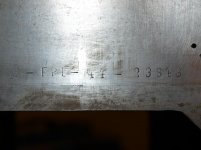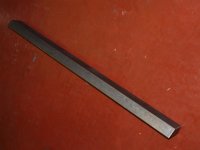jbentley11
Plastic
- Joined
- Aug 19, 2016
I am in the process of rebuilding the old Deckel FP1 shown in the following photos and it has been suggested that a write up may be of interest to others.


The main body casting is stamped with the interlaced FD symbol and FP1-44-23843 as per the following photo, so I assume that the 44 relates to 1944 as the manufacturing date of the original machine.

The machine has been rebuilt previously by Precision Grinding Limited here in the UK (Mitcham, Surrey) and sold badged as an Alexander machine. As part of this rebuild the machine was fitted with a roller bearing horizontal spindle and an Alexander vertical head and slotting attachment. Although Alexander Master Toolmaker machines were near copies of the first generation Deckel FP1 they differed, as has been noted before on this site, in being fitted with 20° pressure angle gearing rather than the 14.5° used by Deckel. However, in the case of my machine the vertical and slotting heads are fitted with 14.5° gears to mesh with the original Deckel gearing.
Although purchased over two years ago the machine has been stored in the garage until I commenced the rebuild in September last year, although some preparatory work was undertaken earlier. I do not propose to describe the detail of the work, but to provide an overview of processes and sequence I am using.
As was intending to scrape all of the slides; the first activity was to manufacture a bevelled straight edge shown in the following photos.

The straight edge is 34” long to allow it to be utilised for the main ways on the vertical face of the column. I established the angle for the existing dovetail slides by using a vernier protractor at the extreme top of the front column where the slide is completely unworn. The angle of the table and saddle dovetails where also checked on the least worn sections and were found to match the 60° of those on the column.
The straight edge was manufactured from a piece of continuously cast iron bar which was rough milled to shape and allowed to ‘weather’ for approximately 8 months before any further work was undertaken. It was then rough scraped before being allowed a further 6 months to ‘weather’ before finish scraping.
The scraping was undertaken using an old Biax and an inspection grade 24” x 18” granite surface plate as the master. The angle was checked with a vernier protractor.
I do not proposed to describe the stripping down of the machine, but in the next posting I will show the condition of the vertical slides and commence a summary of the processes I utilised for scrapping these surfaces.


The main body casting is stamped with the interlaced FD symbol and FP1-44-23843 as per the following photo, so I assume that the 44 relates to 1944 as the manufacturing date of the original machine.

The machine has been rebuilt previously by Precision Grinding Limited here in the UK (Mitcham, Surrey) and sold badged as an Alexander machine. As part of this rebuild the machine was fitted with a roller bearing horizontal spindle and an Alexander vertical head and slotting attachment. Although Alexander Master Toolmaker machines were near copies of the first generation Deckel FP1 they differed, as has been noted before on this site, in being fitted with 20° pressure angle gearing rather than the 14.5° used by Deckel. However, in the case of my machine the vertical and slotting heads are fitted with 14.5° gears to mesh with the original Deckel gearing.
Although purchased over two years ago the machine has been stored in the garage until I commenced the rebuild in September last year, although some preparatory work was undertaken earlier. I do not propose to describe the detail of the work, but to provide an overview of processes and sequence I am using.
As was intending to scrape all of the slides; the first activity was to manufacture a bevelled straight edge shown in the following photos.

The straight edge is 34” long to allow it to be utilised for the main ways on the vertical face of the column. I established the angle for the existing dovetail slides by using a vernier protractor at the extreme top of the front column where the slide is completely unworn. The angle of the table and saddle dovetails where also checked on the least worn sections and were found to match the 60° of those on the column.
The straight edge was manufactured from a piece of continuously cast iron bar which was rough milled to shape and allowed to ‘weather’ for approximately 8 months before any further work was undertaken. It was then rough scraped before being allowed a further 6 months to ‘weather’ before finish scraping.
The scraping was undertaken using an old Biax and an inspection grade 24” x 18” granite surface plate as the master. The angle was checked with a vernier protractor.
I do not proposed to describe the stripping down of the machine, but in the next posting I will show the condition of the vertical slides and commence a summary of the processes I utilised for scrapping these surfaces.
Attachments
Last edited:


